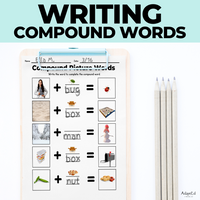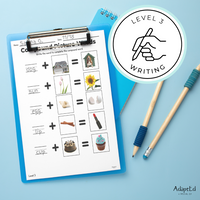Compound Words Writing
Breaking compound words into two parts and writing one of the words down can be helpful in teaching children how to read and write because it helps them learn about word families and patterns.
- Level 1: Visual Support + Tracing
- Level 2: Writing + Visual Support
- Level 3: Writing
9 printable pages included (3 at each level)
This activity also encourages children to focus on the individual sounds within words, which can help them with spelling and decoding unfamiliar words.
For non-verbal students and those with intellectual disabilities, learning how to read and write can be a challenge.
However, research has shown that using multisensory approaches can be effective in teaching literacy skills to these students. For example, a study by O'Connor et al.
(2019) found that using visual cues such as pictures or gestures along with speech can improve literacy outcomes for students with intellectual disabilities.
In addition, breaking compound words into two parts can be helpful for students who struggle with language development or have difficulty processing information.
By focusing on individual parts of a word rather than the whole word, these students may find it easier to understand the meaning of the word and how it relates to other words.
Overall, practicing CVC words through activities such as breaking compound words into two parts can be beneficial for all early readers, including non-verbal students and those with intellectual disabilities.
It helps develop their phonemic awareness skills while also helping them learn about word families and patterns.
Sources: O'Connor, B., O'Connor, J., & Simon, E. (2019). The effects of a multisensory approach to literacy instruction on the phonological awareness skills of students with intellectual disability. Education and Training in Autism and Developmental Disabilities, 54(1), 20-31.
 Previous Product
Previous Product
 Next Product
Next Product













